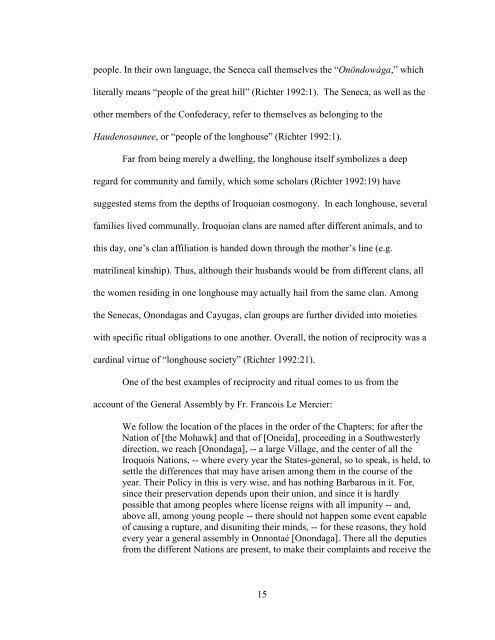archaeological and textual records - eCommons@Cornell - Cornell ...
archaeological and textual records - eCommons@Cornell - Cornell ...
archaeological and textual records - eCommons@Cornell - Cornell ...
Create successful ePaper yourself
Turn your PDF publications into a flip-book with our unique Google optimized e-Paper software.
people. In their own language, the Seneca call themselves the “Onöndowága,” which<br />
literally means “people of the great hill” (Richter 1992:1). The Seneca, as well as the<br />
other members of the Confederacy, refer to themselves as belonging to the<br />
Haudenosaunee, or “people of the longhouse” (Richter 1992:1).<br />
Far from being merely a dwelling, the longhouse itself symbolizes a deep<br />
regard for community <strong>and</strong> family, which some scholars (Richter 1992:19) have<br />
suggested stems from the depths of Iroquoian cosmogony. In each longhouse, several<br />
families lived communally. Iroquoian clans are named after different animals, <strong>and</strong> to<br />
this day, one’s clan affiliation is h<strong>and</strong>ed down through the mother’s line (e.g.<br />
matrilineal kinship). Thus, although their husb<strong>and</strong>s would be from different clans, all<br />
the women residing in one longhouse may actually hail from the same clan. Among<br />
the Senecas, Onondagas <strong>and</strong> Cayugas, clan groups are further divided into moieties<br />
with specific ritual obligations to one another. Overall, the notion of reciprocity was a<br />
cardinal virtue of “longhouse society” (Richter 1992:21).<br />
One of the best examples of reciprocity <strong>and</strong> ritual comes to us from the<br />
account of the General Assembly by Fr. Francois Le Mercier:<br />
We follow the location of the places in the order of the Chapters; for after the<br />
Nation of [the Mohawk] <strong>and</strong> that of [Oneida], proceeding in a Southwesterly<br />
direction, we reach [Onondaga], -- a large Village, <strong>and</strong> the center of all the<br />
Iroquois Nations, -- where every year the States-general, so to speak, is held, to<br />
settle the differences that may have arisen among them in the course of the<br />
year. Their Policy in this is very wise, <strong>and</strong> has nothing Barbarous in it. For,<br />
since their preservation depends upon their union, <strong>and</strong> since it is hardly<br />
possible that among peoples where license reigns with all impunity -- <strong>and</strong>,<br />
above all, among young people -- there should not happen some event capable<br />
of causing a rupture, <strong>and</strong> disuniting their minds, -- for these reasons, they hold<br />
every year a general assembly in Onnontaé [Onondaga]. There all the deputies<br />
from the different Nations are present, to make their complaints <strong>and</strong> receive the<br />
15

















